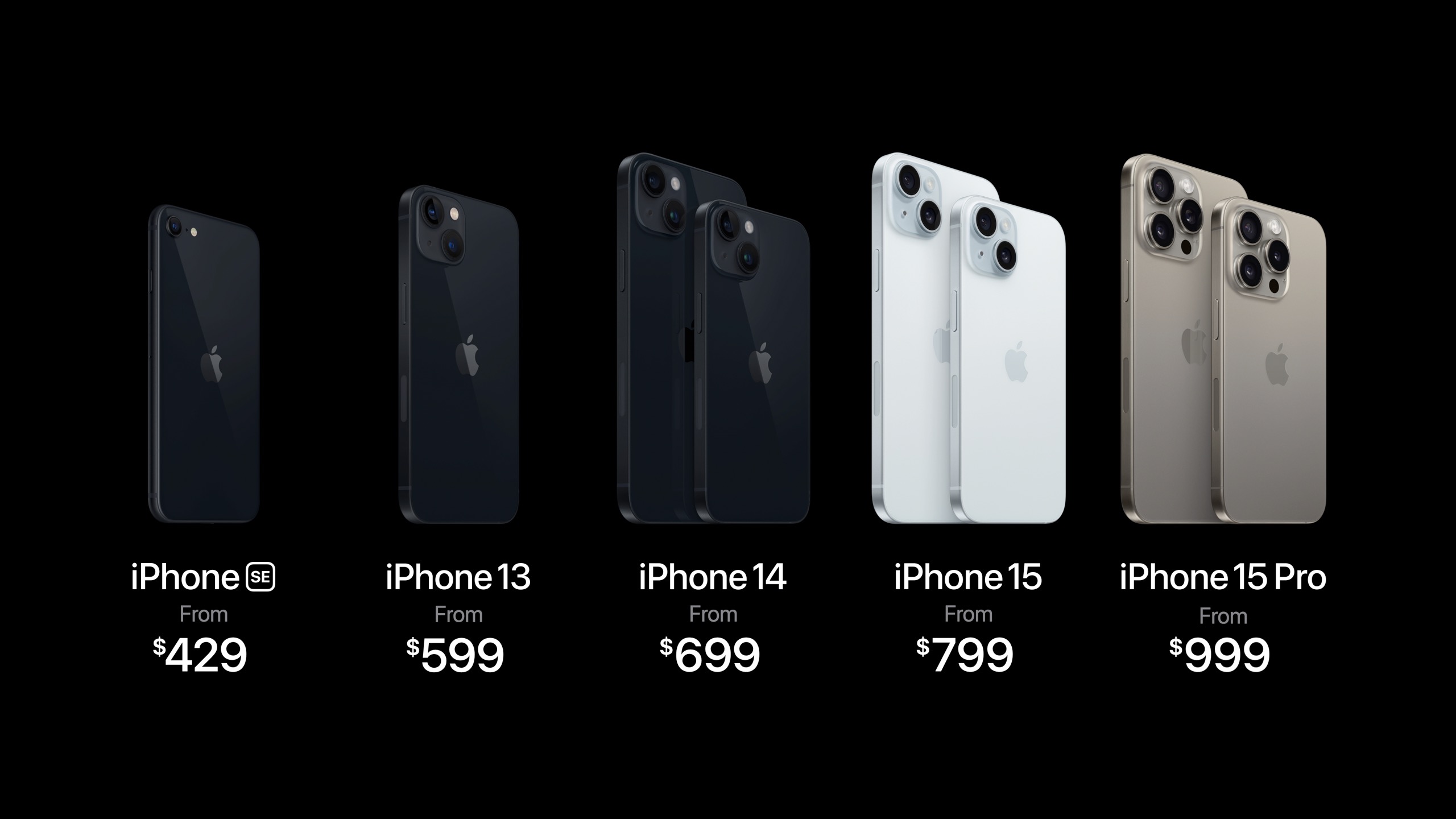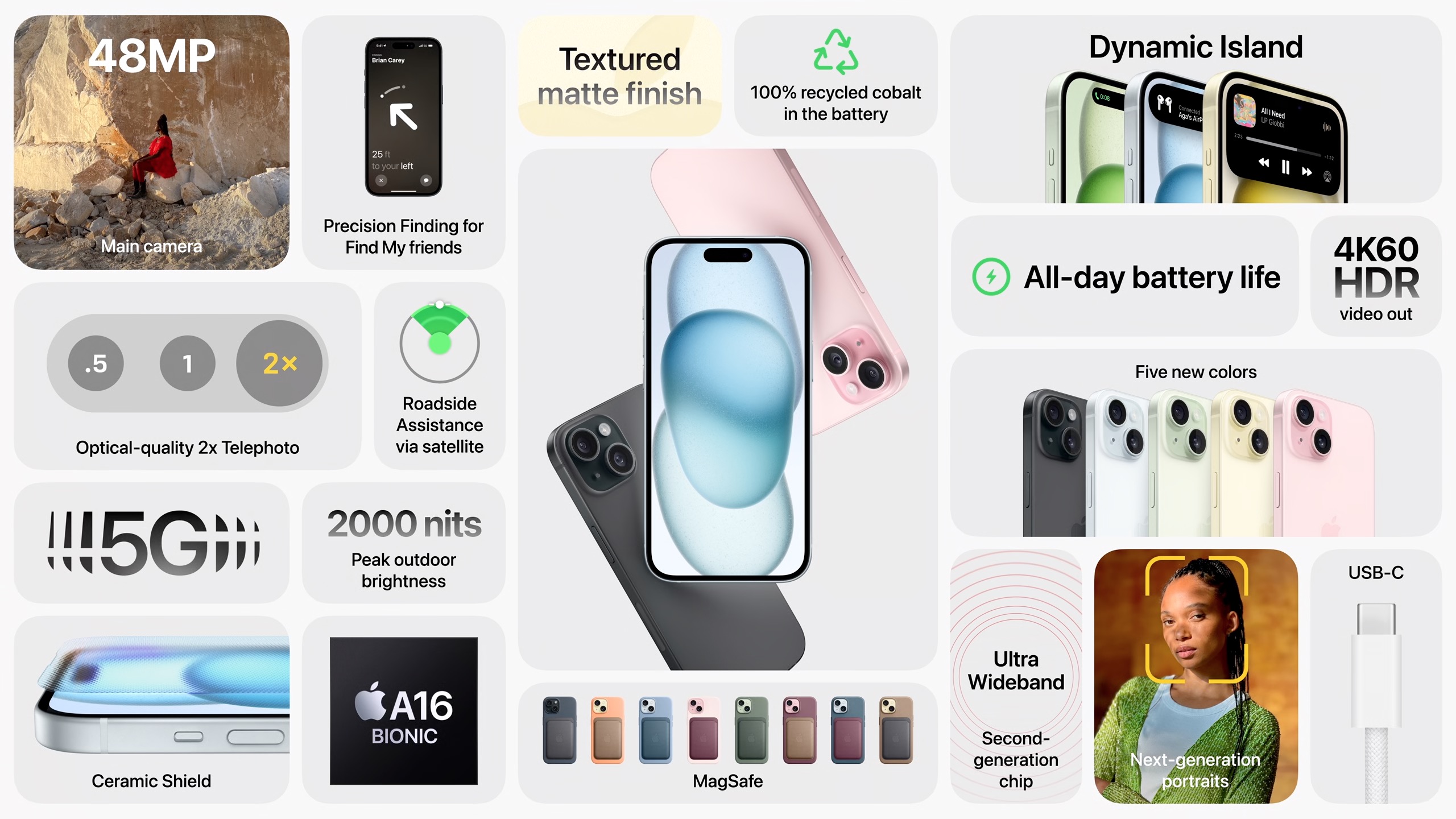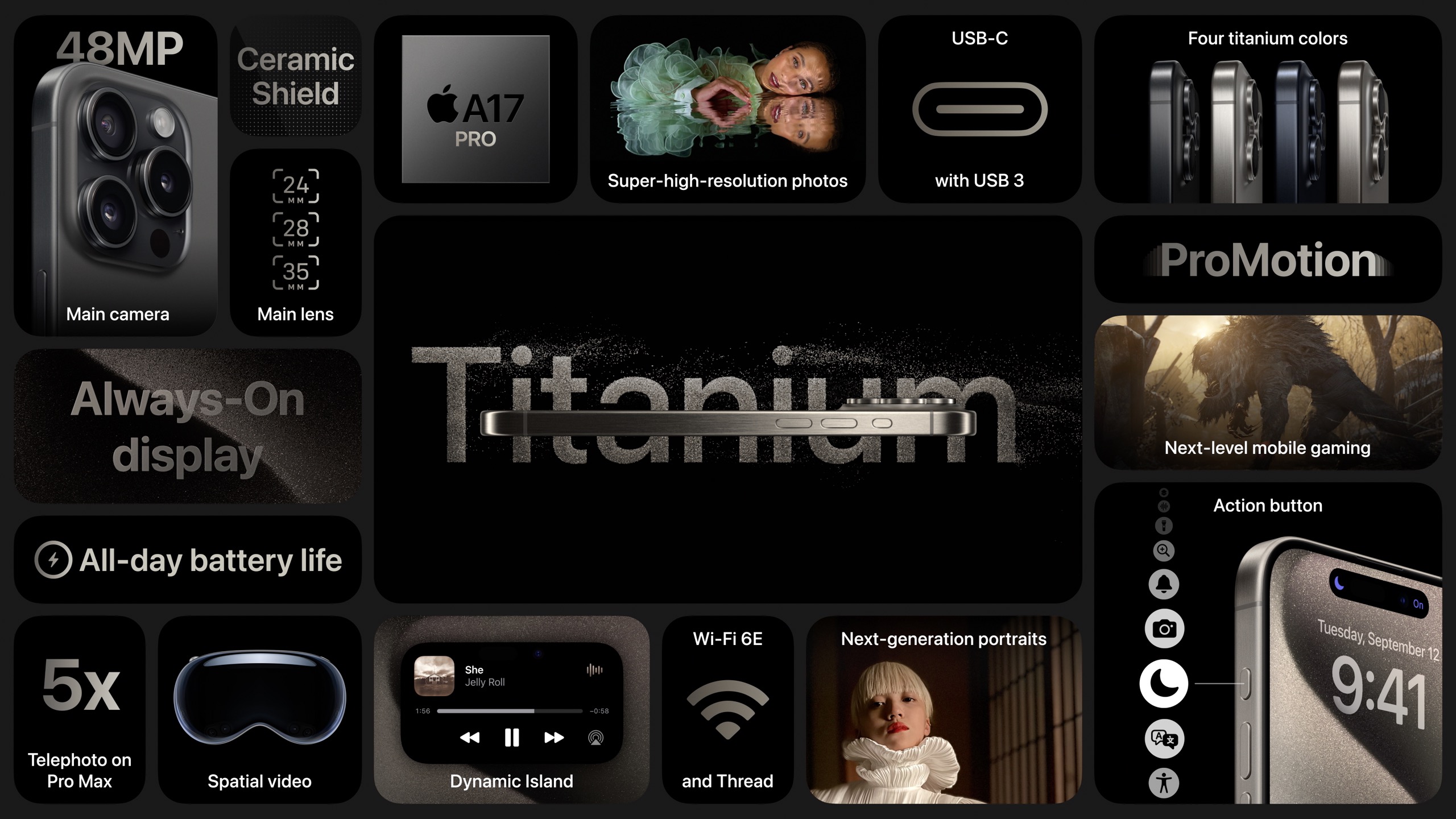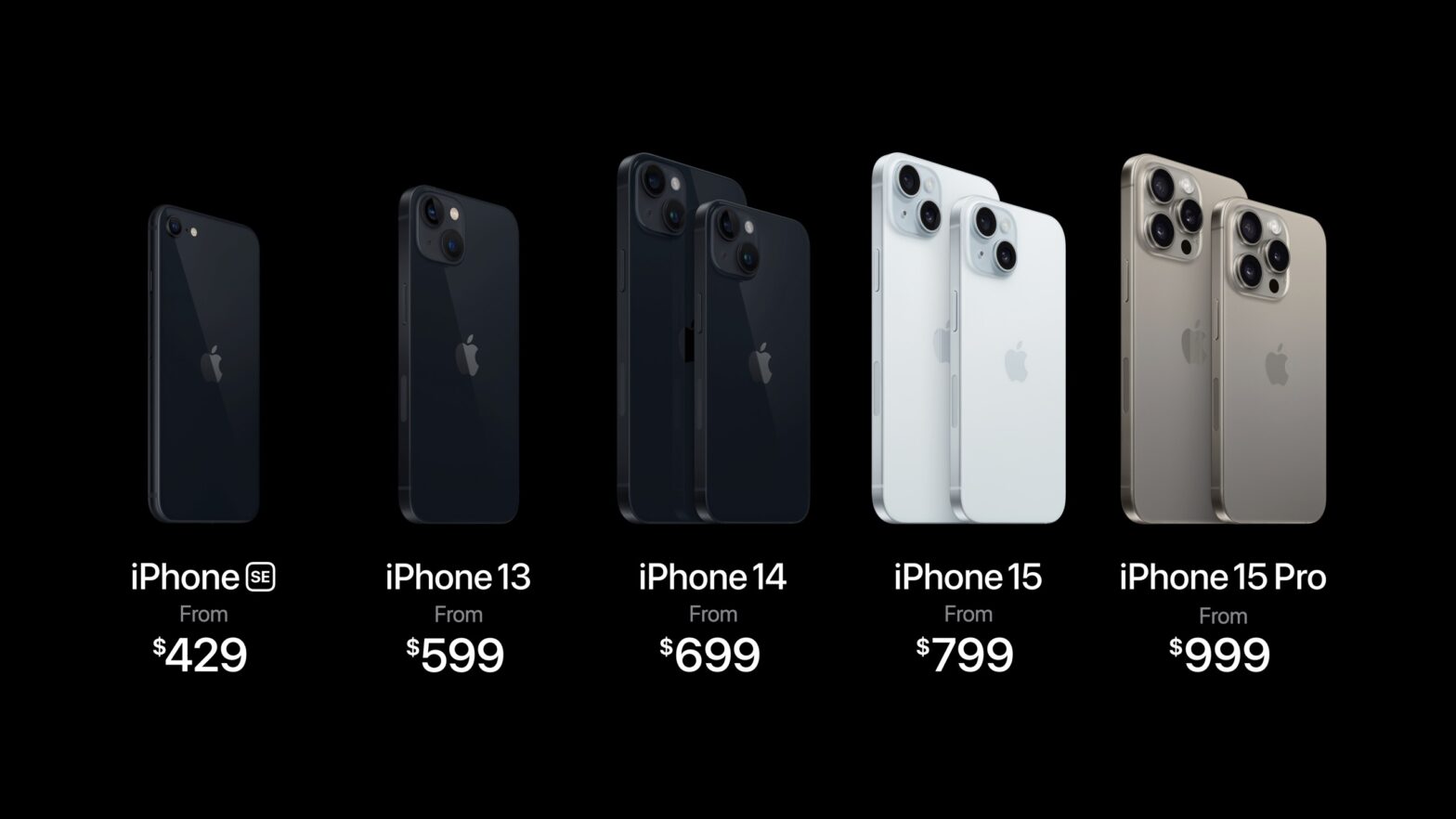[ad_1]
At its Wonderlust event on 12 September 2023, Apple unveiled the iPhone 15 lineup with primarily incremental improvements. In keeping with last year’s approach, Apple introduced the 6.1-inch iPhone 15 and 6.7-inch iPhone 15 Plus along with the 6.1-inch iPhone 15 Pro and 6.7-inch iPhone 15 Pro Max. The third-generation iPhone SE, iPhone 13, and iPhone 14 remain available to provide lower-cost options (see “Apple Unveils Four Models of the iPhone 14,” 7 September 2022). The iPhone 13 mini disappears from the mix, sadly marking the end of Apple’s 5.4-inch iPhones.

You can pre-order the new iPhone 15 models on Friday, 15 September 2023, and they’ll be available a week later on 22 September 2023.
iPhone 15 and iPhone 15 Plus
Although Apple continues to innovate more on the Pro end of the lineup, the basic iPhone 15 and iPhone 15 Plus improve on their predecessors in various ways, some in part due to the adoption of the A16 Bionic chip from the iPhone 14 Pro.
- USB-C: The most apparent change, shared by the Pro models, is the replacement of the Lightning port with USB-C for charging and data transfer. Unsurprisingly, Apple focused on the benefits of USB-C and made no mention of the EU’s requirement that all electronics use a common charger starting in 2024.
- Dynamic Island: The iPhone 15 gains the Dynamic Island that debuted last year in the iPhone 14 Pro. It’s a subtle but effective way to display alerts and Live Activities in the area surrounding the camera and sensor package at the top of the screen, eliminating the need for a distracting notch.
- 48-megapixel camera: In a significant jump, the iPhone 15 gets a 48-megapixel camera that promises better photos than the previous generation’s 12-megapixel camera. By default, it combines pixels for a 24-megapixel image bolstered by computational photography. It also provides an effective 2x telephoto option by using just the 12 megapixels in the center of the sensor, giving the iPhone 15 optical-quality zoom levels of 0.5x, 1x, and 2x.
- Computational photography improvements: The camera now detects people, dogs, and cats and captures depth information for Portrait mode, which can be applied after the fact. It’s also possible to adjust the focal point after the fact. Other changes improve photos taken in Night mode and using Smart HDR.
- Roadside Assistance via satellite: This expansion to Emergency SOS via satellite enables iPhone 15 users suffering car problems in areas without cellular coverage to call for assistance. Access to satellite services is included for 2 years, and AAA membership in the US covers the roadside service. Those who aren’t AAA members will be able to purchase service separately.
- Second-generation UWB chip: Apple’s second-generation Ultra Wideband chip enables Precision Finding at three times the range as before when used to locate other devices with the second-generation chip. That makes Precision Finding with Find My Friends practical in crowds.

The iPhone 15 and iPhone 15 Plus will be available in pink, yellow, green, blue, and black in 128 GB, 256 GB, and 512 GB storage capacities, starting at $799 and $899, respectively.
iPhone 15 Pro and iPhone 15 Pro Max
As much as many people bemoan the cost of Apple products, Apple does very well selling premium products at premium prices. Nowhere is that more evident than with the iPhone 15 Pro and iPhone 15 Pro Max, where Apple charges $200 more than the base model for innovative features. Along with the Roadside Assistance via satellite and second-generation Ultra Wideband chip, the Pro-only features this year include:
- A17 Pro chip: The latest version of Apple’s iPhone (and likely iPad) chip offers 10% faster CPU performance (than last year’s A16 Bionic), twice the Neural Engine performance, and a new 6-core GPU design that’s 20% faster. There’s also a dedicated AV1 decoder for better streaming video experiences. If you do things on your iPhone that seem slow now—video streaming or mobile gaming, perhaps—you’ll appreciate the new chip. Either way, it will quickly become the new normal.
- USB-C with USB 3 speeds: Although all iPhone 15 models have a USB-C port, the iPhone 15 Pro models support USB 3 transfer speeds of 10 gigabits per second. That also allows video output up to 4K at 60 frames per second.
- Wi-Fi 6e and Thread support: For those needing maximum wireless performance, Apple says the iPhone 15 Pro’s support for Wi-Fi 6e can provide up to twice the bandwidth. Thread support could enable future opportunities for Home app integrations.
- Titanium exterior: I’m not one to gush about different materials, mainly because most phones end up in protective cases, but Apple made a big deal about how the iPhone 15 Pro features an aerospace-grade titanium exterior and aluminum interior for strength, durability, and reduced weight. Both models are only 19 grams lighter—about the weight of four credit cards—and while that’s welcome, it’s not game-changing.
- Action button: Apple replaced the Ring/Silent switch with a customizable Action button, activated by pressing and holding. By default, it still puts the iPhone into silent mode, but you can set what you want it to do, such as activate Voice Memos, set Focus modes, access the camera or flashlight, enable Accessibility options, or launch a Shortcut. It features haptic feedback and shows visual cues in the Dynamic Island.
- Better photos: Both models of the iPhone 15 Pro get an even better 48-megapixel camera and receive the same computational photography upgrades as the base models that provide 24-megapixel default photos, better low-light photos in Night mode, more vibrant images with Smart HDR, and automatic Portrait mode. But the iPhone 15 Pro Max gains a 5x Telephoto camera thanks to a tetraprism design—the rumored “periscope” camera.

The iPhone 15 Pro and iPhone 15 Pro Max will be available in four finishes: black titanium, white titanium, blue titanium, and natural titanium. The iPhone 15 Pro starts at $999 for 128 GB, with 256 GB, 512 GB, and 1 TB storage options. The iPhone 15 Pro Max starts at $1199 for 256 GB, with 512 GB and 1 TB storage options. Last year’s iPhone 14 Pro Max started at $1099, but that was for 128 GB, which is no longer an option, so the prices are comparable. Or, if you take inflation into account, lower.
Upgrade Decisions
Last year, we suggested that there wasn’t much reason to upgrade to the iPhone 14, but the iPhone 14 Pro, with its 48-megapixel camera, Always-On display, and Dynamic Island, was more compelling. This year, I think the reverse is true.
Because the iPhone 15 gains the A16 Bionic chip, 48-megapixel camera, Dynamic Island, and computational photography improvements, it’s an easier upgrade decision if you’re coming from an iPhone 12 or iPhone 13. It’s harder to recommend upgrading from an iPhone 14 that’s only a year old, but even that jump is likely something you’ll notice.
However, the improvements in the iPhone 15 Pro over the iPhone 14 Pro are likely to be appreciated mostly by professionals. Most people won’t notice the increased performance of the A17 Pro, USB 3, and Wi-Fi 6e. As always, the camera improvements will gain a wide fan base, but the 5x Telephoto camera is available only on the iPhone 15 Pro Max, and many people (like me) who would otherwise appreciate it would never consider such a large phone.
As such, I can’t recommend most people upgrade from an iPhone 14 Pro, and only the camera improvements and Action button tempt me to trade mine in. If you’re using an iPhone 13 Pro or anything older, it’s an easier decision because you’d also gain the features that set the iPhone 14 Pro apart.
Where do you come down on the upgrade decision?
[ad_2]
